On a moody, rainy April afternoon in Detroit, we met with
Tom Forrest, Shinola’s Executive Guest Manager for an
unforgettable glimpse inside the Shinola Hotel.
Nestled in the heart of Detroit, on the busiest corner of Woodward Avenue, stands a bright red building. It holds its own amongst the city’s most storied architectural gems. Just like the rest of them, it has walls that have endless history to tell. If you want to hear them talk, all you have to do is walk in the door.
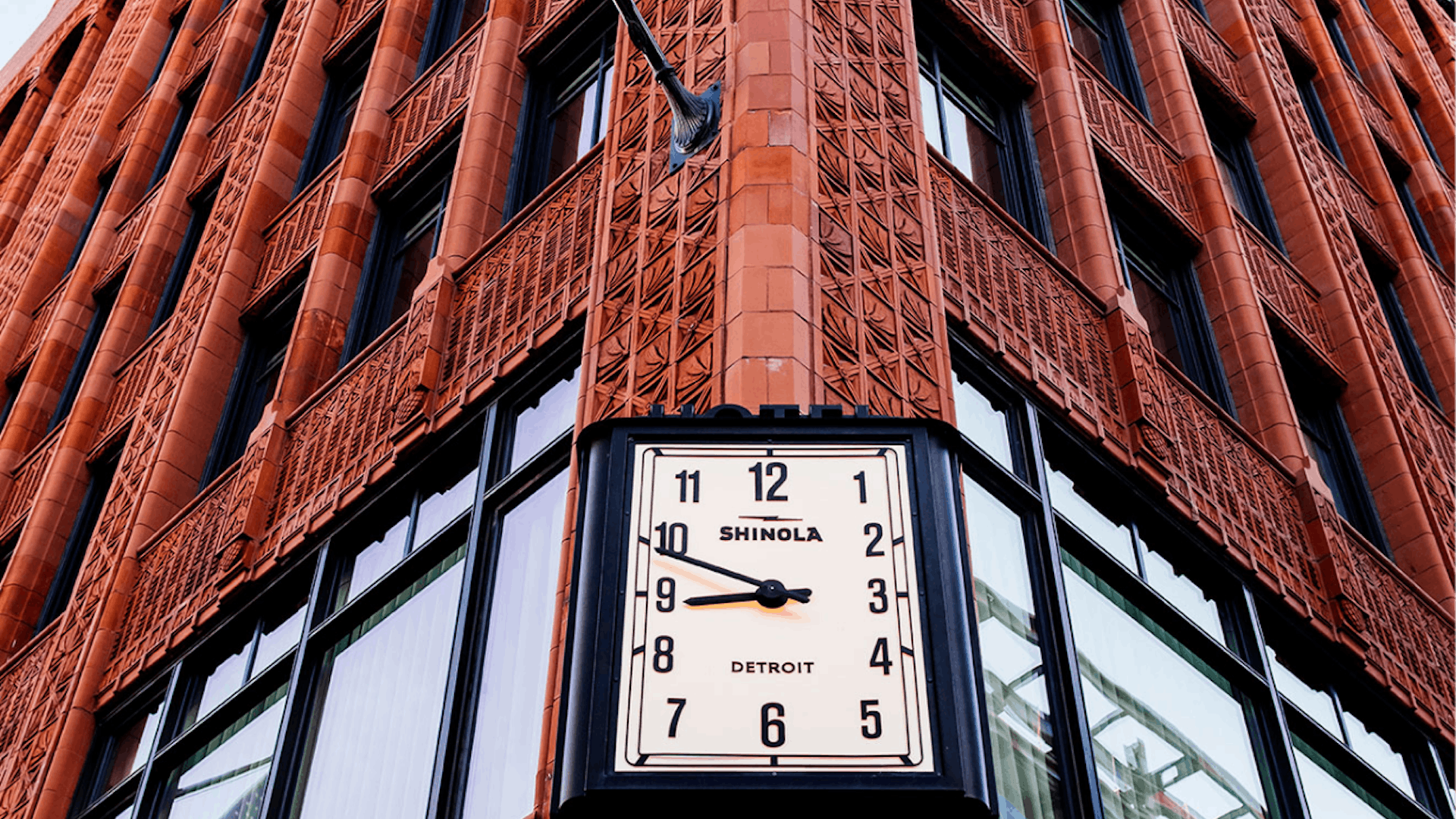 Outside of the Shinola Hotel, on the busiest corner of downtown Detroit.
Outside of the Shinola Hotel, on the busiest corner of downtown Detroit.
LET THE WALLS DO THE TALKING
Dodging the heavy drops of spring rain on a gloomy April afternoon, I dashed through the doors of the Shinola Hotel.
I found myself in the lobby, appropriately named “The Living Room.” Perhaps this is because it effortlessly fits the collective definition of what we imagine our dream home to look and feel like.
Its walls are filled with art, reflecting
the talent of today while honoring the artists of yesterday. The collection is curated by Library Street Collective. Meanwhile, a mix of vintage and custom-made furniture offers equal parts beauty and comfort to those looking to take a load off. Shinola’s signature hotel scent subtly sets the mood.
Sitting beneath the focal point of the entire room—a glimmering beaded masterpiece called “Tondo” by Nick Cave—was Tom Forrest, Shinola’s Executive Guest Manager, a proud Detroit transplant, and one of the friendliest faces you’ll encounter during
your stay.
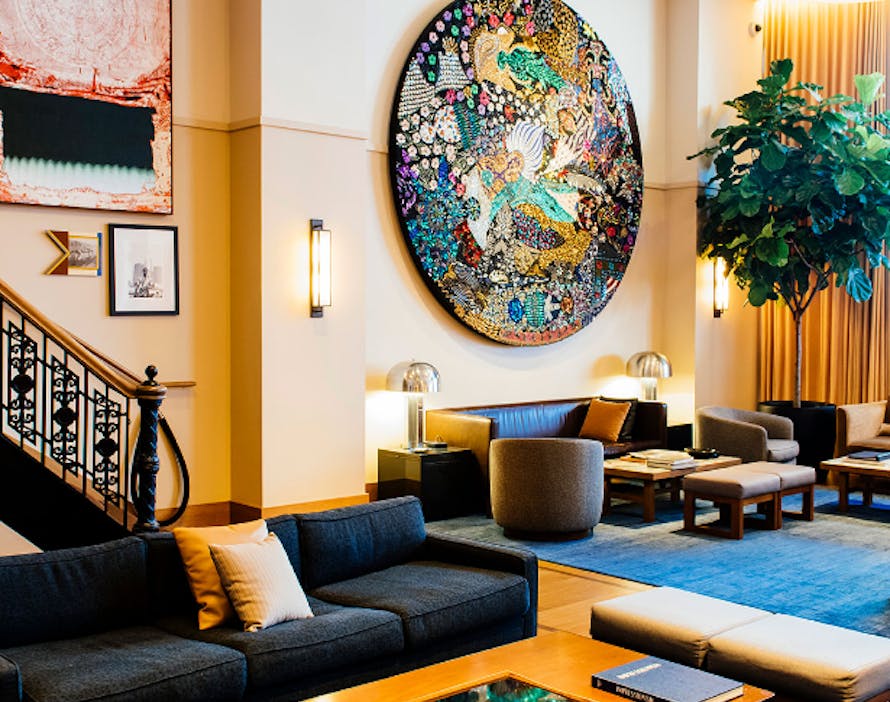 The Living Room.
The Living Room.
 Tom Forrest, Shinola’s Executive Guest Manager.
Tom Forrest, Shinola’s Executive Guest Manager.
The hotel is Forrest’s office. On any given day, you’ll find him working in the Living Room, tucked away in the Mezzanine, also known as Saksey’s Lounge, or walking about the halls. A key part of his job is to ensure the happiness of the hotel’s guests. But if you happen to stop and chat, what you’ll leave with is a story you’ll never forget.
“Hospitality is important to me because I moved around a lot and was always the new kid,” Forrest said.
For Forrest, hospitality is more than just making people comfortable and happy, it’s about being there to make the magic happen. It’s a story he tells well.
“I’ve always been able to pick up on things and
put myself in other’s shoes. I don’t think it’s something
that you can be taught, it’s just who you are.”
BUILDING IT LIKE THEY USED TO
Like everything we make, the hotel is built with the same timeless style and obsessive
attention to detail.
The building’s history was the first thing Tom taught me as we climbed the grand staircase to Saksey’s Lounge, one of the only original pieces left from when it was built in 1915. It was carefully restored as the Hotel was being constructed about a half-decade ago.
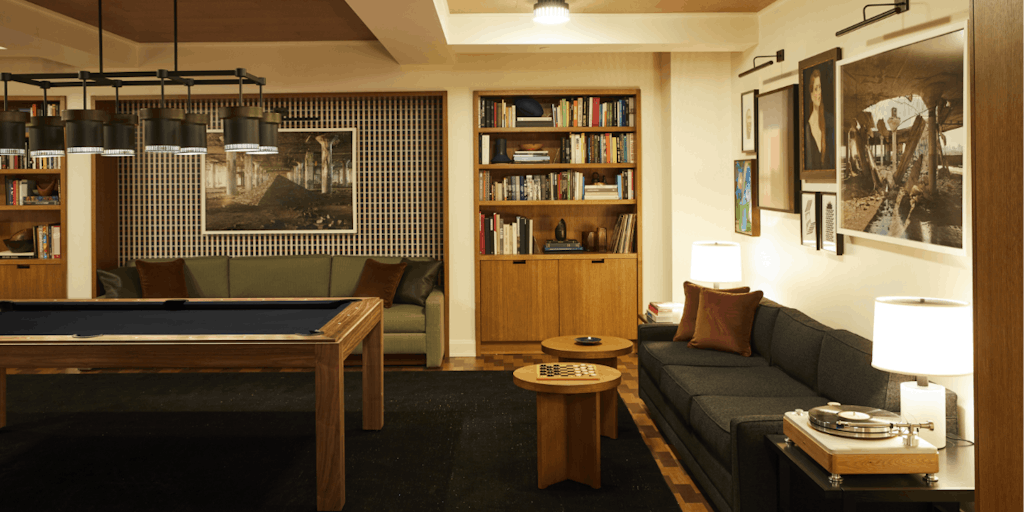 Saksey’s Lounge.
Saksey’s Lounge.
The hotel’s main structure was built by the T.B. Rayl Company in 1915, a hardware and sporting goods store. Wirt Rowland was the architect behind the elaborate, red-tiled façade and was known for exploring new design methods and materials. His use of terra cotta on Rayl’s became distinctive
in Detroit.
Rowland would later go on to design some of Detroit’s most recognizable structures: the Guardian Building—adorned with Pewabic tile and Parducci sculpture—and the Penobscot Building—known for the glowing red sphere topping its spire.
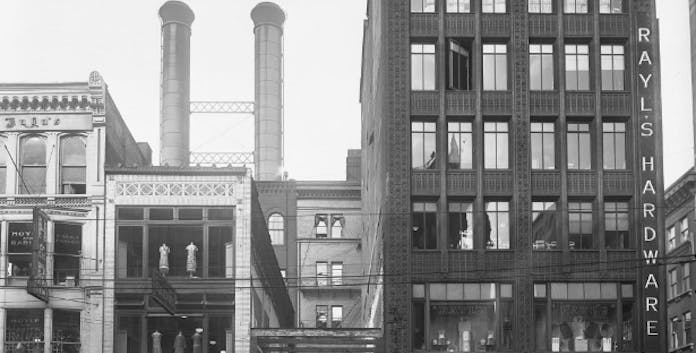 The building before the hotel circa 1925.
The building before the hotel circa 1925.
Over the years, the current Shinola Hotel property housed many retailers, including Liggett’s Drug Store, Lloyd’s Furs, and Sally Frocks. It’s believed that the hand-painted sign nestled in the wall today in the quiet Mezzanine may have belonged to the Meyer Jewelry Company. Although Forrest reminds me, that factoid is still up for debate.
During the construction of the hotel, builders found many hidden treasures of the past, including unique wallpaper from the 1920s that designers replicated and incorporated all throughout the modernized building. Most of the wallpaper within the hotel is designed by Detroit Wallpaper.
Tom then turned my attention to the floor we stood on. He referenced the lines that separated the rooms, representing the threshold of where history was made, and new craft began.
Today, the Shinola Hotel property occupies five buildings, including the historic former Singer Building in addition to Rayl’s. The adjacent Singer Building was home to the Singer Sewing Machine Company in 1936. The company sold sewing machines, fabric, and patterns. It was designed by Detroit-based Smith, Hinchman and Grylls. Now called the SmithGroup, it’s the nation’s oldest continuously operating architectural engineering planning firm.
“The construction guys who worked on this hotel would tell me ‘You know, Tom, no one is building things like this anymore,”’ Forrest laughed. More than a century later, Shinola has helped prove that the era of quality craftsmanship is still alive in Detroit.
A ROOM WITH A VIEW
Shinola’s commitment to quality and craft can be felt throughout the Hotel. The magic happens when you realize every room frames that commitment in a different perspective.
The elevator encased in solid white oak stopped on the 5th floor. The doors slid open to reveal windows looking out on the Motor City. I realized that we were truly in the heart of it all, from the colorful and bustling Parker’s Alley below to the wonderous view of the Book Tower above.
As I walked down the hallway, I began to see the brand painted in a new light, quite literally—the iconic Shinola blue hue covers the walls, creating a calming atmosphere. The guest suites give a whole new meaning to the Shinola promise: Built to be lived in, worn out and well loved.
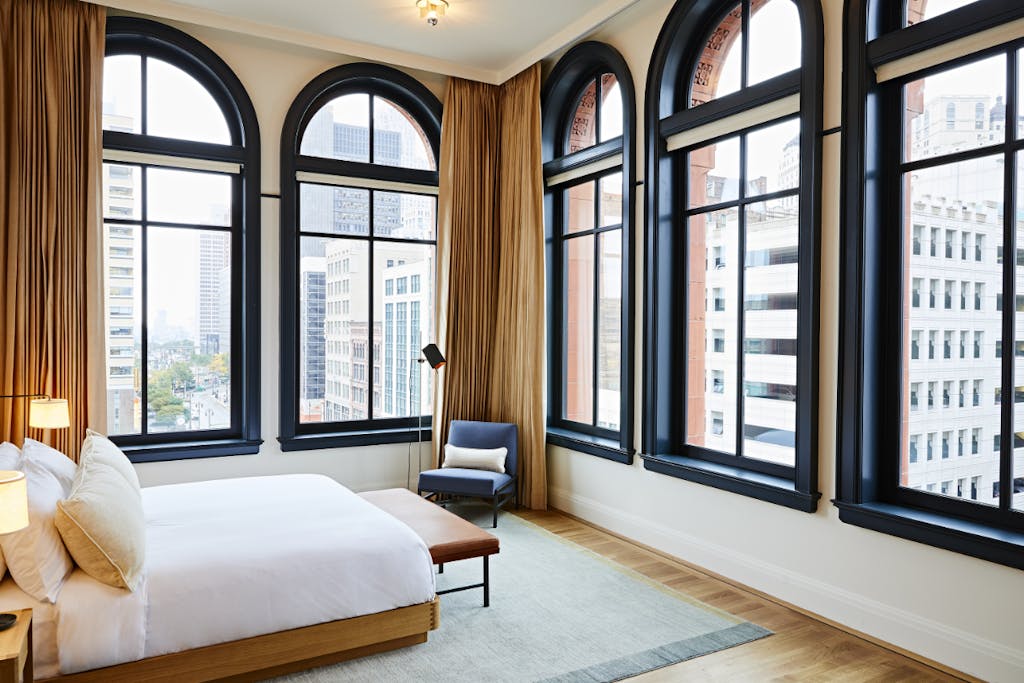 A room with a stunning view.
A room with a stunning view.
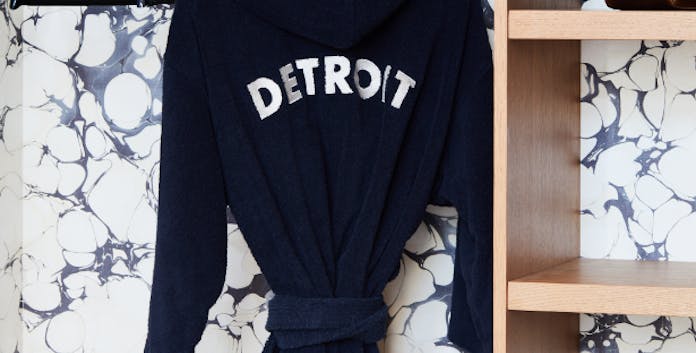 Thoughtful touches of home.
Thoughtful touches of home.
Every room is crafted to feel like home, welcoming you in with humble touches of Shinola. The details indulge all five senses—from the plush feel of robes with “Detroit” emblazed on them, chevron wallpaper taken from our handcrafted Clue gameboard to the smooth sounds coming from the turntable.
“Every time you look, you’ll find a hint of Shinola that you didn’t see before,” Forrest said. I looked again and saw my favorite detail, the bathroom sink faucets modeled after watch casebacks, a stunning collaboration with Waterworks.
Even the soap is thoughtfully adorned with the Rayl’s name, an everyday reminder of the greatness that came before.
“I look at this place and don’t think it will ever go out of style,” Tom said with a knowing smile.
“It lives up to everything we do—making things that are built to last forever.”
It true, even though the hotel is little more than four years old, it feels like it has been a part of Detroit for decades.
A FULL CIRCLE STAY
Telling Shinola’s story and bringing it full circle for guests is Forrest’s favorite part of the job.“People think we’re just a hotel, but when they find out about Shinola it’s an amazing discovery.”
The hotel is only a part of what the brand has had the opportunity to build in Detroit. To Forrest, no trip to the city is complete without seeing where it all began, so he turned the Shinola watch factory, located just north of the hotel, into a must-see destination.
“When I take guests to tour the factory, I can see it all click for them. The factory could be completely empty on the weekends, and you can still feel the passion and understand what we’re all about.”
 A watchmaker at work in the Shinola Factory.
A watchmaker at work in the Shinola Factory.
Just as Shinola is defined by the hard work at the factory, the hotel wouldn’t be what it is today without the people who built it and continue to craft its story every day. Its sincere, warm, and timeless nature are all thanks to people like Tom Forrest and those who work in our stores and factory.
The hardest part of that April afternoon had arrived, and it was time to say goodbye. My head still buzzing with the stories I heard, I stepped back out on to that lively corner of the city with a new one of my own to tell.
I could go on about that special place in Detroit where quality craftsmanship and hospitality are alive and well, but it’s best that you see it for yourself.
 The Shinola Hotel in all its glory.
The Shinola Hotel in all its glory.